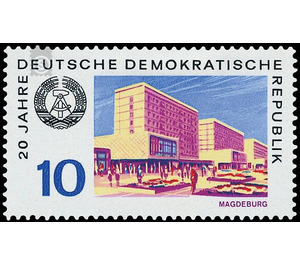Leipzig Autumn Fair - Germany / German Democratic Republic 1969 - 10 Pfennig
| Country | Germany / German Democratic Republic |
| Issue Date | 1969 |
| Face Value | 10.00 |
| Color | violet blue |
| Perforation | K 14 |
| Printing Type | Photogravure |
| Stamp Type | Postage stamp |
| Item Type | Stamp |
| Chronological Issue Number | 1242 |
| Chronological Chapter | GER-DDR |
| SID | 940874 |
| In 22 Wishlists | |
Building socialist city centers and cities in the GDR On the 20th anniversary of the German Democratic Republic, twelve multi-colored special postage stamps and a multi-colored special postage stamp block on the construction of socialist city centers and cities in the GDR are published. New Cities in the New State Proud of having opened the socialist epoch of German history, and with the scientifically accurate picture of a safe and beautiful future in mind, the citizens of the German Democratic Republic celebrate the 20th anniversary of the founding of their state. Under the leadership of the working class and its revolutionary party, the Socialist Unity Party of Germany, the entire working people have laid the unshakable foundations of socialism on which today the building of the developed socialist society is growing ever higher and more beautiful. With the German Democratic Republic, a German state of peace and freedom, humanity and social justice has emerged for the first time in the long history of the German people. With the twentieth birthday of this young socialist state German nation a proud record of the successes of two decades is connected. Urbanism is also a reflection of the new, and in recent years it has been increasingly successful in architecturally expressing the advantages of the socialist order. And so twelve special stamps and a special block on the 20th anniversary of the GDR are not accidentally dedicated to this topic. The development of the cities and municipalities of the German Democratic Republic took place in the last 20 years in different stages, which are determined by the economic possibilities and the social necessities. The first stage, which lasted until about 1955, was characterized by the fact that all efforts were made to overcome the greatest war damage. The call of the Central Committee of the Socialist Unity Party of Germany on November 25, 1951 for the rebuilding of the capital Berlin and for the creation of the National Assembly (NAW) played an important role. For the first time, urban planning was given the task of developing completely new norms of building on the way to socialism. Characteristic of this stage are u. a. The first phase of construction of the Berlin Karl-Marx-Allee, the beginning of Eisenhüttenstadt's construction and the extensive restoration of destroyed, valuable historic monuments in the Second World War, such as the Berlin State Opera or the Dresden Zwinger. A second stage was initiated in 1955 with the 1st Building Conference and characterized by the beginning industrialization of construction, the implementation of the principle of the construction of socialist housing complexes in type planning and the creation of the first high-performance road transport systems in the cities. Striking construction works of this section are for example the second part of the Karl-Marx-Allee and the reconstruction of the street Unter den Linden in Berlin, the street of the nations in Karl Marx city as well as the modern living cities Hoyerswerda and Schwedt. Finally, the third stage began with the evaluation of the seminal resolutions of the Seventh Party Congress of the SED in 1967. It is characterized by the effort to achieve fundamental and concentrated transformation of the centers of the most important cities of the Republic. The motives of the present issue also report on this development. In detail are presented: Magdeburg with blocks of flats and shops in the Karl-Marx-Straße. And these are just a few selected examples from a plethora of similar images from all parts of the German Democratic Republic in the twentieth year of their existence.


